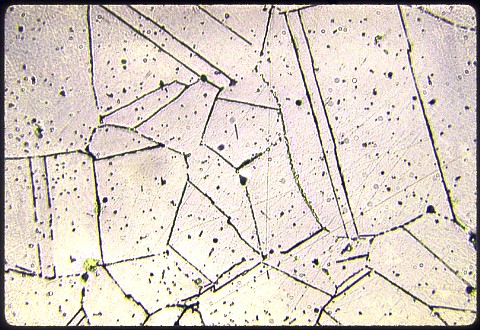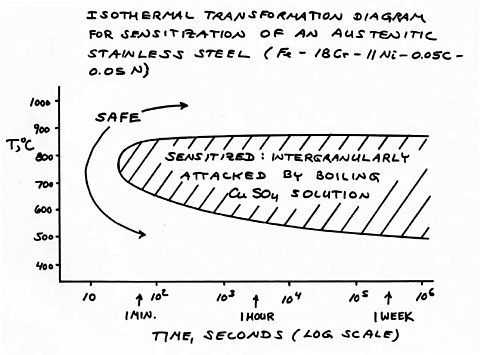Microstructures
by
George
Langford, Sc.D., Massachusetts Institute of Technology, Cambridge, MA,
1966
Copyright©2005 by George Langford
Cast Irons, High Alloy Steels,
and Superalloys - Lesson 2 - Third specimen
 A
tensile testing grip, made of this 18% Cr - 8% Ni stainless
steel, failed in service at 650C. A
tensile testing grip, made of this 18% Cr - 8% Ni stainless
steel, failed in service at 650C.
Why ?
Note the annealing twins in this FCC
material. It has been electrolytically etched in an oxalic acid
solution and is shown at 500X magnification.
Think about the
present context
and then move to the explanation.
|
Explanation:
It has been
sensitized at the 650C operating temperature. The formation of
Cr4C
depleted the austenite grain boundaries of chromium, a nonadherent
scale (surface oxide) of FeO formed, and oxidation
destroyed
the grip by rapid diffusion of carbon along the grain boundaries.
The steel was unsuited for the application.
|

|
This TTT diagram (Time-Temperature-Transformation)
shows that sensitization occurs most rapidly (i.e., in a few minutes)
at 600C to 850C, but hardly at all below 500C. The only useful
18-8 stainless steel for this service would therefore have to be free
of dissolved carbon.
|
 A
tensile testing grip, made of this 18% Cr - 8% Ni stainless
steel, failed in service at 650C.
A
tensile testing grip, made of this 18% Cr - 8% Ni stainless
steel, failed in service at 650C.